Analyzing the Social Model of Health in a Global Context
VerifiedAdded on 2020/03/04
|10
|2251
|41
Essay
AI Summary
This essay provides a comprehensive overview of the social model of health, contrasting it with the biomedical model and highlighting its significance in addressing global health issues. It examines the increasing life expectancy in developed countries versus the disparities in developing countries, and the shift in mortality and morbidity rates. The essay explores the impact of the social model on HIV/AIDS prevalence in Sub-Saharan Africa and coronary heart disease in New Zealand, emphasizing the importance of behavioral, social, and environmental factors. The social determinants of health and biopsychosocial models are discussed in the context of these health challenges. The essay concludes by advocating for health awareness programs and preventive measures to reduce the burden of disease, emphasizing the need for a holistic approach that considers the interplay of biological, psychological, and social factors in health outcomes.
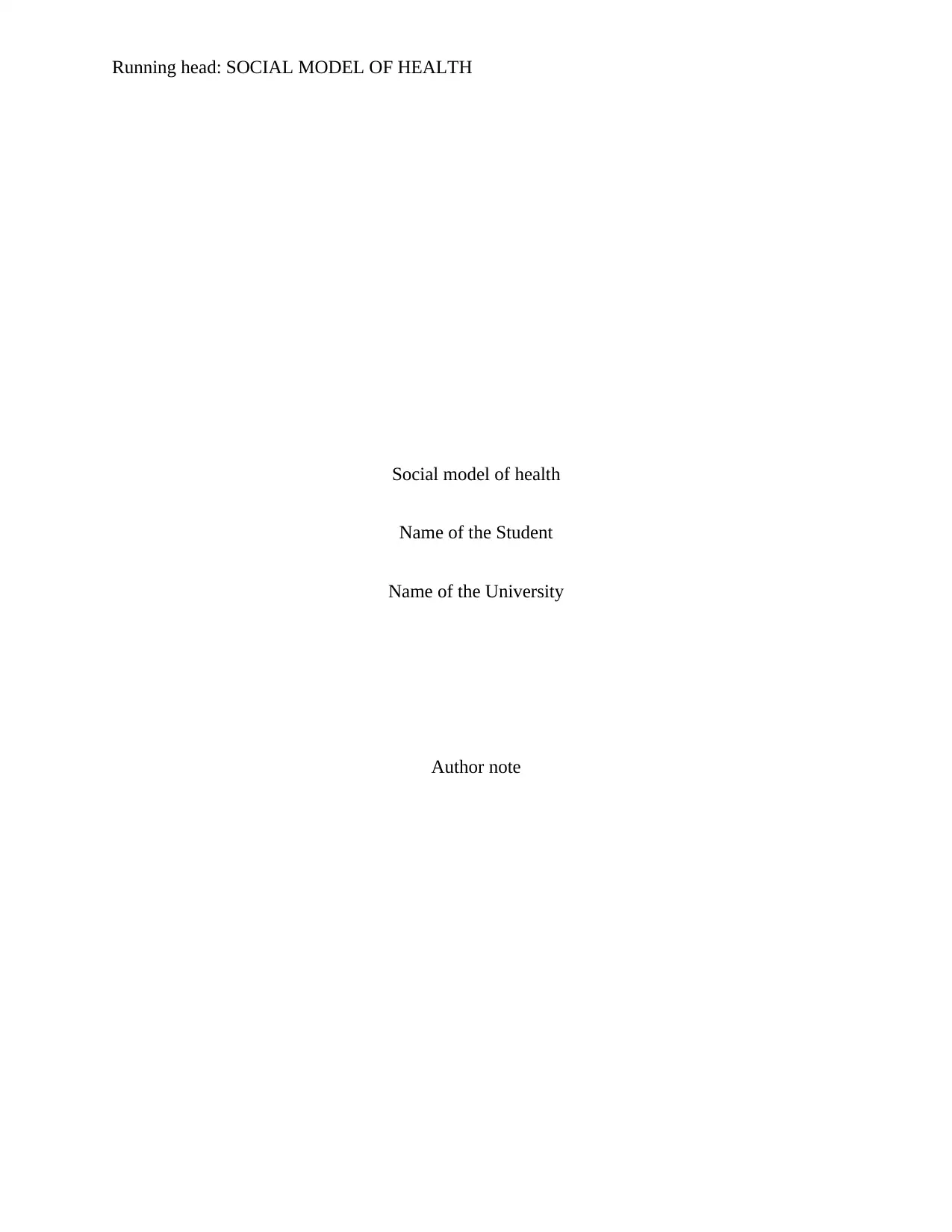
Running head: SOCIAL MODEL OF HEALTH
Social model of health
Name of the Student
Name of the University
Author note
Social model of health
Name of the Student
Name of the University
Author note
Paraphrase This Document
Need a fresh take? Get an instant paraphrase of this document with our AI Paraphraser
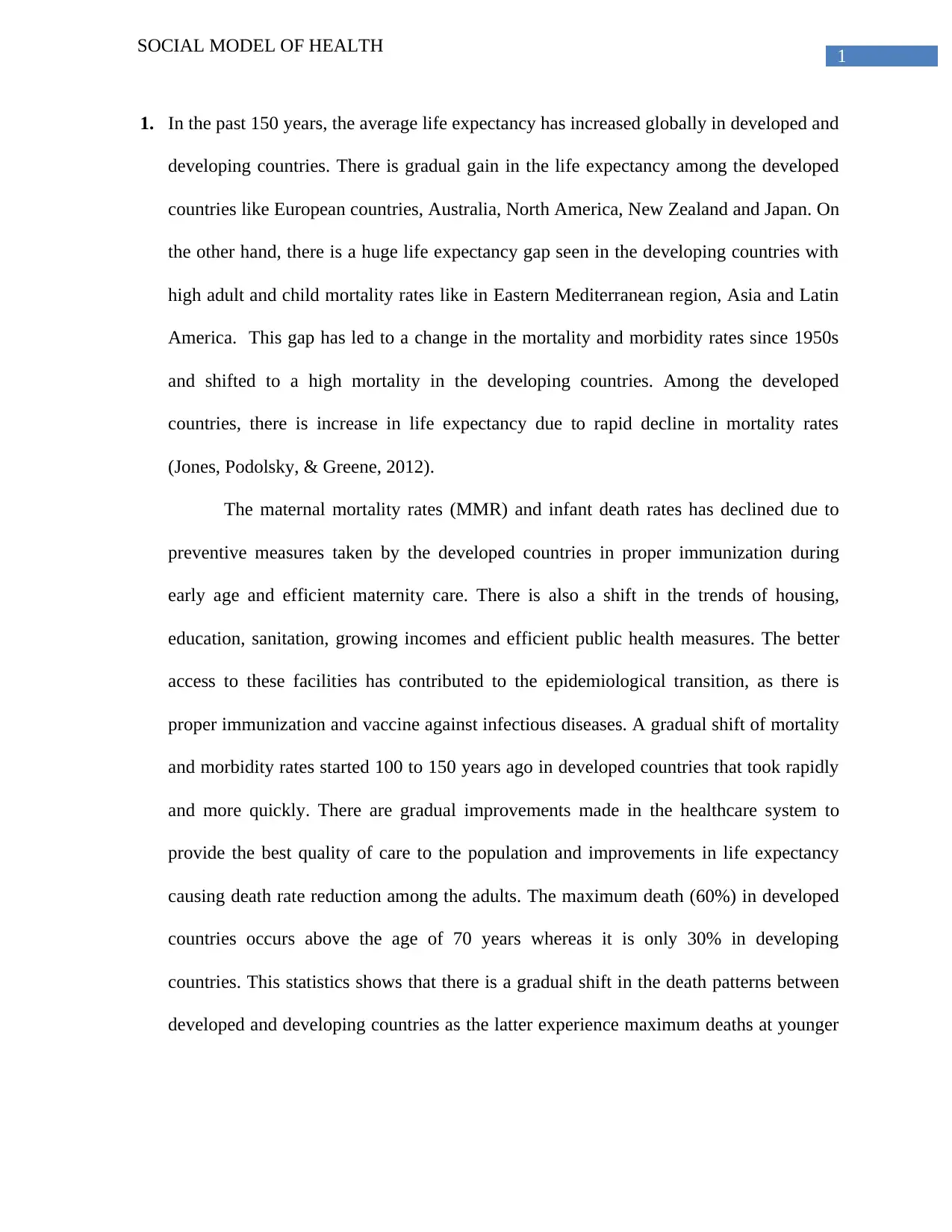
1
SOCIAL MODEL OF HEALTH
1. In the past 150 years, the average life expectancy has increased globally in developed and
developing countries. There is gradual gain in the life expectancy among the developed
countries like European countries, Australia, North America, New Zealand and Japan. On
the other hand, there is a huge life expectancy gap seen in the developing countries with
high adult and child mortality rates like in Eastern Mediterranean region, Asia and Latin
America. This gap has led to a change in the mortality and morbidity rates since 1950s
and shifted to a high mortality in the developing countries. Among the developed
countries, there is increase in life expectancy due to rapid decline in mortality rates
(Jones, Podolsky, & Greene, 2012).
The maternal mortality rates (MMR) and infant death rates has declined due to
preventive measures taken by the developed countries in proper immunization during
early age and efficient maternity care. There is also a shift in the trends of housing,
education, sanitation, growing incomes and efficient public health measures. The better
access to these facilities has contributed to the epidemiological transition, as there is
proper immunization and vaccine against infectious diseases. A gradual shift of mortality
and morbidity rates started 100 to 150 years ago in developed countries that took rapidly
and more quickly. There are gradual improvements made in the healthcare system to
provide the best quality of care to the population and improvements in life expectancy
causing death rate reduction among the adults. The maximum death (60%) in developed
countries occurs above the age of 70 years whereas it is only 30% in developing
countries. This statistics shows that there is a gradual shift in the death patterns between
developed and developing countries as the latter experience maximum deaths at younger
SOCIAL MODEL OF HEALTH
1. In the past 150 years, the average life expectancy has increased globally in developed and
developing countries. There is gradual gain in the life expectancy among the developed
countries like European countries, Australia, North America, New Zealand and Japan. On
the other hand, there is a huge life expectancy gap seen in the developing countries with
high adult and child mortality rates like in Eastern Mediterranean region, Asia and Latin
America. This gap has led to a change in the mortality and morbidity rates since 1950s
and shifted to a high mortality in the developing countries. Among the developed
countries, there is increase in life expectancy due to rapid decline in mortality rates
(Jones, Podolsky, & Greene, 2012).
The maternal mortality rates (MMR) and infant death rates has declined due to
preventive measures taken by the developed countries in proper immunization during
early age and efficient maternity care. There is also a shift in the trends of housing,
education, sanitation, growing incomes and efficient public health measures. The better
access to these facilities has contributed to the epidemiological transition, as there is
proper immunization and vaccine against infectious diseases. A gradual shift of mortality
and morbidity rates started 100 to 150 years ago in developed countries that took rapidly
and more quickly. There are gradual improvements made in the healthcare system to
provide the best quality of care to the population and improvements in life expectancy
causing death rate reduction among the adults. The maximum death (60%) in developed
countries occurs above the age of 70 years whereas it is only 30% in developing
countries. This statistics shows that there is a gradual shift in the death patterns between
developed and developing countries as the latter experience maximum deaths at younger
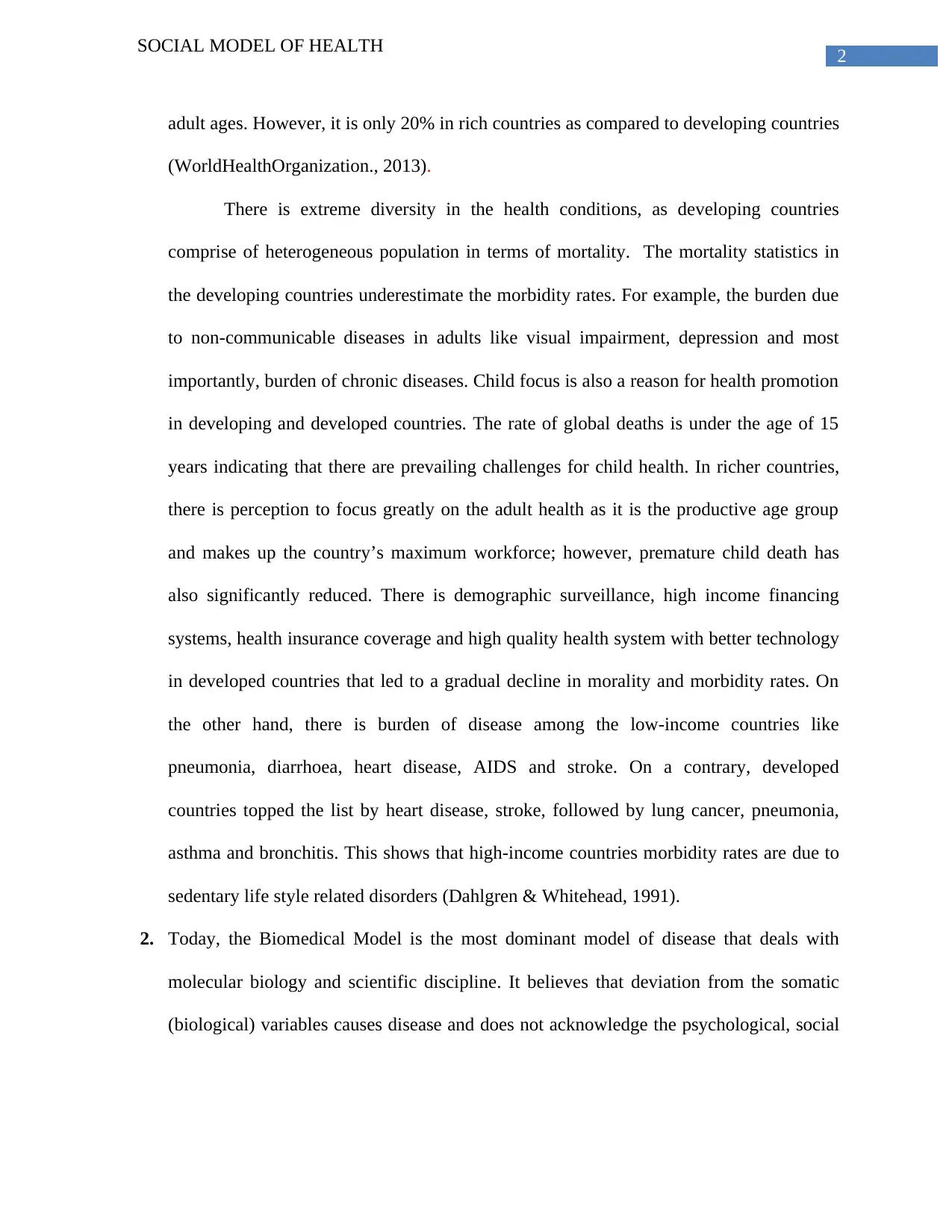
2
SOCIAL MODEL OF HEALTH
adult ages. However, it is only 20% in rich countries as compared to developing countries
(WorldHealthOrganization., 2013).
There is extreme diversity in the health conditions, as developing countries
comprise of heterogeneous population in terms of mortality. The mortality statistics in
the developing countries underestimate the morbidity rates. For example, the burden due
to non-communicable diseases in adults like visual impairment, depression and most
importantly, burden of chronic diseases. Child focus is also a reason for health promotion
in developing and developed countries. The rate of global deaths is under the age of 15
years indicating that there are prevailing challenges for child health. In richer countries,
there is perception to focus greatly on the adult health as it is the productive age group
and makes up the country’s maximum workforce; however, premature child death has
also significantly reduced. There is demographic surveillance, high income financing
systems, health insurance coverage and high quality health system with better technology
in developed countries that led to a gradual decline in morality and morbidity rates. On
the other hand, there is burden of disease among the low-income countries like
pneumonia, diarrhoea, heart disease, AIDS and stroke. On a contrary, developed
countries topped the list by heart disease, stroke, followed by lung cancer, pneumonia,
asthma and bronchitis. This shows that high-income countries morbidity rates are due to
sedentary life style related disorders (Dahlgren & Whitehead, 1991).
2. Today, the Biomedical Model is the most dominant model of disease that deals with
molecular biology and scientific discipline. It believes that deviation from the somatic
(biological) variables causes disease and does not acknowledge the psychological, social
SOCIAL MODEL OF HEALTH
adult ages. However, it is only 20% in rich countries as compared to developing countries
(WorldHealthOrganization., 2013).
There is extreme diversity in the health conditions, as developing countries
comprise of heterogeneous population in terms of mortality. The mortality statistics in
the developing countries underestimate the morbidity rates. For example, the burden due
to non-communicable diseases in adults like visual impairment, depression and most
importantly, burden of chronic diseases. Child focus is also a reason for health promotion
in developing and developed countries. The rate of global deaths is under the age of 15
years indicating that there are prevailing challenges for child health. In richer countries,
there is perception to focus greatly on the adult health as it is the productive age group
and makes up the country’s maximum workforce; however, premature child death has
also significantly reduced. There is demographic surveillance, high income financing
systems, health insurance coverage and high quality health system with better technology
in developed countries that led to a gradual decline in morality and morbidity rates. On
the other hand, there is burden of disease among the low-income countries like
pneumonia, diarrhoea, heart disease, AIDS and stroke. On a contrary, developed
countries topped the list by heart disease, stroke, followed by lung cancer, pneumonia,
asthma and bronchitis. This shows that high-income countries morbidity rates are due to
sedentary life style related disorders (Dahlgren & Whitehead, 1991).
2. Today, the Biomedical Model is the most dominant model of disease that deals with
molecular biology and scientific discipline. It believes that deviation from the somatic
(biological) variables causes disease and does not acknowledge the psychological, social
⊘ This is a preview!⊘
Do you want full access?
Subscribe today to unlock all pages.

Trusted by 1+ million students worldwide
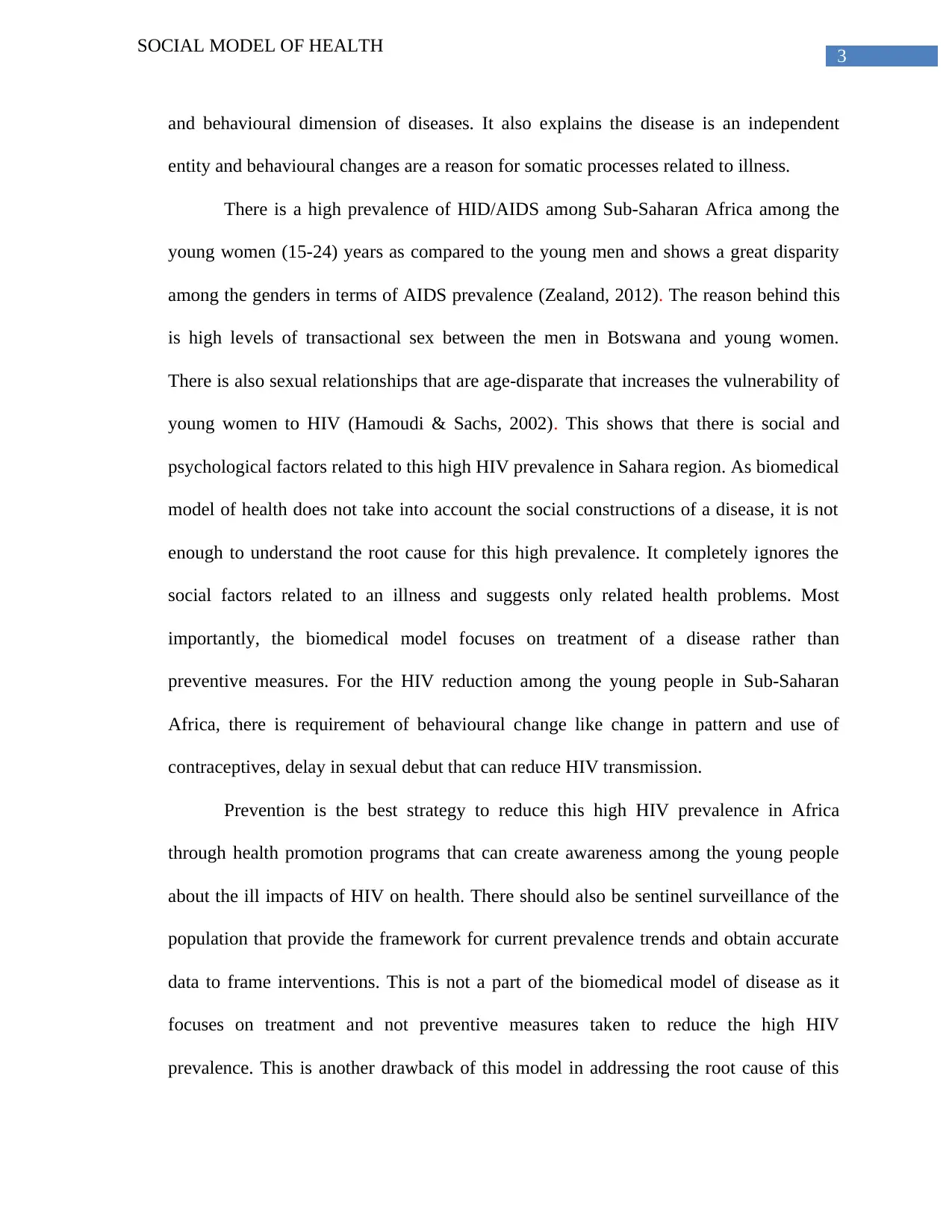
3
SOCIAL MODEL OF HEALTH
and behavioural dimension of diseases. It also explains the disease is an independent
entity and behavioural changes are a reason for somatic processes related to illness.
There is a high prevalence of HID/AIDS among Sub-Saharan Africa among the
young women (15-24) years as compared to the young men and shows a great disparity
among the genders in terms of AIDS prevalence (Zealand, 2012). The reason behind this
is high levels of transactional sex between the men in Botswana and young women.
There is also sexual relationships that are age-disparate that increases the vulnerability of
young women to HIV (Hamoudi & Sachs, 2002). This shows that there is social and
psychological factors related to this high HIV prevalence in Sahara region. As biomedical
model of health does not take into account the social constructions of a disease, it is not
enough to understand the root cause for this high prevalence. It completely ignores the
social factors related to an illness and suggests only related health problems. Most
importantly, the biomedical model focuses on treatment of a disease rather than
preventive measures. For the HIV reduction among the young people in Sub-Saharan
Africa, there is requirement of behavioural change like change in pattern and use of
contraceptives, delay in sexual debut that can reduce HIV transmission.
Prevention is the best strategy to reduce this high HIV prevalence in Africa
through health promotion programs that can create awareness among the young people
about the ill impacts of HIV on health. There should also be sentinel surveillance of the
population that provide the framework for current prevalence trends and obtain accurate
data to frame interventions. This is not a part of the biomedical model of disease as it
focuses on treatment and not preventive measures taken to reduce the high HIV
prevalence. This is another drawback of this model in addressing the root cause of this
SOCIAL MODEL OF HEALTH
and behavioural dimension of diseases. It also explains the disease is an independent
entity and behavioural changes are a reason for somatic processes related to illness.
There is a high prevalence of HID/AIDS among Sub-Saharan Africa among the
young women (15-24) years as compared to the young men and shows a great disparity
among the genders in terms of AIDS prevalence (Zealand, 2012). The reason behind this
is high levels of transactional sex between the men in Botswana and young women.
There is also sexual relationships that are age-disparate that increases the vulnerability of
young women to HIV (Hamoudi & Sachs, 2002). This shows that there is social and
psychological factors related to this high HIV prevalence in Sahara region. As biomedical
model of health does not take into account the social constructions of a disease, it is not
enough to understand the root cause for this high prevalence. It completely ignores the
social factors related to an illness and suggests only related health problems. Most
importantly, the biomedical model focuses on treatment of a disease rather than
preventive measures. For the HIV reduction among the young people in Sub-Saharan
Africa, there is requirement of behavioural change like change in pattern and use of
contraceptives, delay in sexual debut that can reduce HIV transmission.
Prevention is the best strategy to reduce this high HIV prevalence in Africa
through health promotion programs that can create awareness among the young people
about the ill impacts of HIV on health. There should also be sentinel surveillance of the
population that provide the framework for current prevalence trends and obtain accurate
data to frame interventions. This is not a part of the biomedical model of disease as it
focuses on treatment and not preventive measures taken to reduce the high HIV
prevalence. This is another drawback of this model in addressing the root cause of this
Paraphrase This Document
Need a fresh take? Get an instant paraphrase of this document with our AI Paraphraser
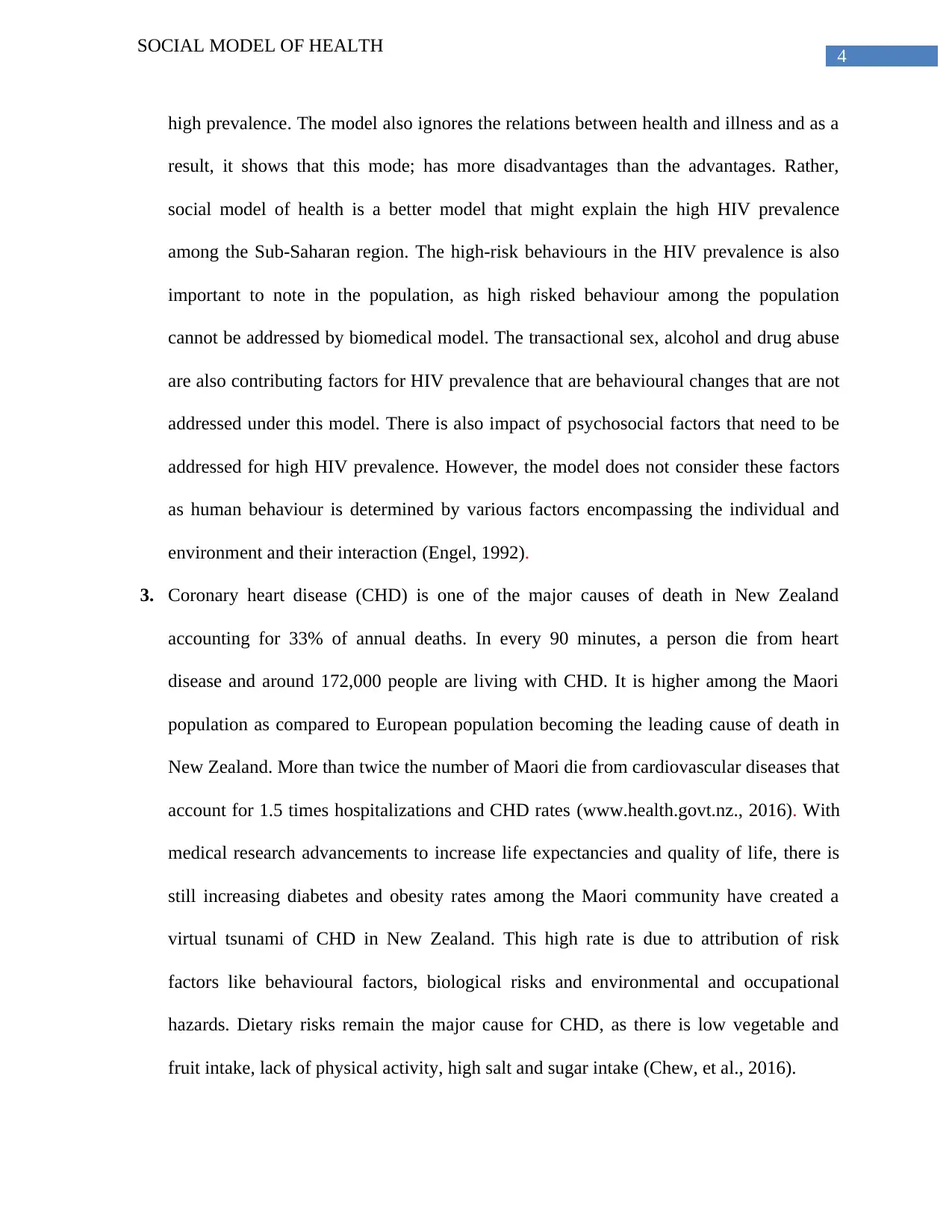
4
SOCIAL MODEL OF HEALTH
high prevalence. The model also ignores the relations between health and illness and as a
result, it shows that this mode; has more disadvantages than the advantages. Rather,
social model of health is a better model that might explain the high HIV prevalence
among the Sub-Saharan region. The high-risk behaviours in the HIV prevalence is also
important to note in the population, as high risked behaviour among the population
cannot be addressed by biomedical model. The transactional sex, alcohol and drug abuse
are also contributing factors for HIV prevalence that are behavioural changes that are not
addressed under this model. There is also impact of psychosocial factors that need to be
addressed for high HIV prevalence. However, the model does not consider these factors
as human behaviour is determined by various factors encompassing the individual and
environment and their interaction (Engel, 1992).
3. Coronary heart disease (CHD) is one of the major causes of death in New Zealand
accounting for 33% of annual deaths. In every 90 minutes, a person die from heart
disease and around 172,000 people are living with CHD. It is higher among the Maori
population as compared to European population becoming the leading cause of death in
New Zealand. More than twice the number of Maori die from cardiovascular diseases that
account for 1.5 times hospitalizations and CHD rates (www.health.govt.nz., 2016). With
medical research advancements to increase life expectancies and quality of life, there is
still increasing diabetes and obesity rates among the Maori community have created a
virtual tsunami of CHD in New Zealand. This high rate is due to attribution of risk
factors like behavioural factors, biological risks and environmental and occupational
hazards. Dietary risks remain the major cause for CHD, as there is low vegetable and
fruit intake, lack of physical activity, high salt and sugar intake (Chew, et al., 2016).
SOCIAL MODEL OF HEALTH
high prevalence. The model also ignores the relations between health and illness and as a
result, it shows that this mode; has more disadvantages than the advantages. Rather,
social model of health is a better model that might explain the high HIV prevalence
among the Sub-Saharan region. The high-risk behaviours in the HIV prevalence is also
important to note in the population, as high risked behaviour among the population
cannot be addressed by biomedical model. The transactional sex, alcohol and drug abuse
are also contributing factors for HIV prevalence that are behavioural changes that are not
addressed under this model. There is also impact of psychosocial factors that need to be
addressed for high HIV prevalence. However, the model does not consider these factors
as human behaviour is determined by various factors encompassing the individual and
environment and their interaction (Engel, 1992).
3. Coronary heart disease (CHD) is one of the major causes of death in New Zealand
accounting for 33% of annual deaths. In every 90 minutes, a person die from heart
disease and around 172,000 people are living with CHD. It is higher among the Maori
population as compared to European population becoming the leading cause of death in
New Zealand. More than twice the number of Maori die from cardiovascular diseases that
account for 1.5 times hospitalizations and CHD rates (www.health.govt.nz., 2016). With
medical research advancements to increase life expectancies and quality of life, there is
still increasing diabetes and obesity rates among the Maori community have created a
virtual tsunami of CHD in New Zealand. This high rate is due to attribution of risk
factors like behavioural factors, biological risks and environmental and occupational
hazards. Dietary risks remain the major cause for CHD, as there is low vegetable and
fruit intake, lack of physical activity, high salt and sugar intake (Chew, et al., 2016).

5
SOCIAL MODEL OF HEALTH
These underlying root causes for high CHD in NZ can be explained through two
models; Social Determinants of Health (SDH) and Biopsychosocial Model of Health.
SDH model is a framework that helps to study the underlying causes of CHD among the
Maori in NZ. The understanding of the social and physical determinants has health
impact on the functioning and health outcomes. Maori have low access to resources like
safe housing, food to meet their daily requirements. There is lack of education and job
opportunities to avail the healthcare services and receive education to lead a healthy life.
There is also lack of social support in terms of health promotion programs and because of
social exclusion, there is lack of awareness among the high-risk population regarding
CHD. SDH also explains that literacy and language is the biggest barrier that prevents
them from seeking support from community-based resources. The physical determinants
include the community design and built environment to provide green space and
sidewalks for performing physical activity. There is lack of economic stability,
inequalities of healthcare services, poor education, socio-economic conditions and family
income. These physical and social determinants are important that addresses the reason
behind the high CHD prevalence (WorldHealthOrganization, 2010).
On the other hand, Biospychosocial Model encompasses the psychological factors
along with social and biological factors that contribute to illness and health. It states that
interplay of these three factors frame the health and one’s predisposition to disease. The
biological factors involve the genetic factors like chromosome 9p21.3 risk allele that is
associated with CHD predisposition. Psychosocial factors like sadness, depression and
irritability is important to address as it also contribute to the burden of disease by
exacerbating the biological predisposition that put the genetically vulnerable Maori
SOCIAL MODEL OF HEALTH
These underlying root causes for high CHD in NZ can be explained through two
models; Social Determinants of Health (SDH) and Biopsychosocial Model of Health.
SDH model is a framework that helps to study the underlying causes of CHD among the
Maori in NZ. The understanding of the social and physical determinants has health
impact on the functioning and health outcomes. Maori have low access to resources like
safe housing, food to meet their daily requirements. There is lack of education and job
opportunities to avail the healthcare services and receive education to lead a healthy life.
There is also lack of social support in terms of health promotion programs and because of
social exclusion, there is lack of awareness among the high-risk population regarding
CHD. SDH also explains that literacy and language is the biggest barrier that prevents
them from seeking support from community-based resources. The physical determinants
include the community design and built environment to provide green space and
sidewalks for performing physical activity. There is lack of economic stability,
inequalities of healthcare services, poor education, socio-economic conditions and family
income. These physical and social determinants are important that addresses the reason
behind the high CHD prevalence (WorldHealthOrganization, 2010).
On the other hand, Biospychosocial Model encompasses the psychological factors
along with social and biological factors that contribute to illness and health. It states that
interplay of these three factors frame the health and one’s predisposition to disease. The
biological factors involve the genetic factors like chromosome 9p21.3 risk allele that is
associated with CHD predisposition. Psychosocial factors like sadness, depression and
irritability is important to address as it also contribute to the burden of disease by
exacerbating the biological predisposition that put the genetically vulnerable Maori
⊘ This is a preview!⊘
Do you want full access?
Subscribe today to unlock all pages.

Trusted by 1+ million students worldwide
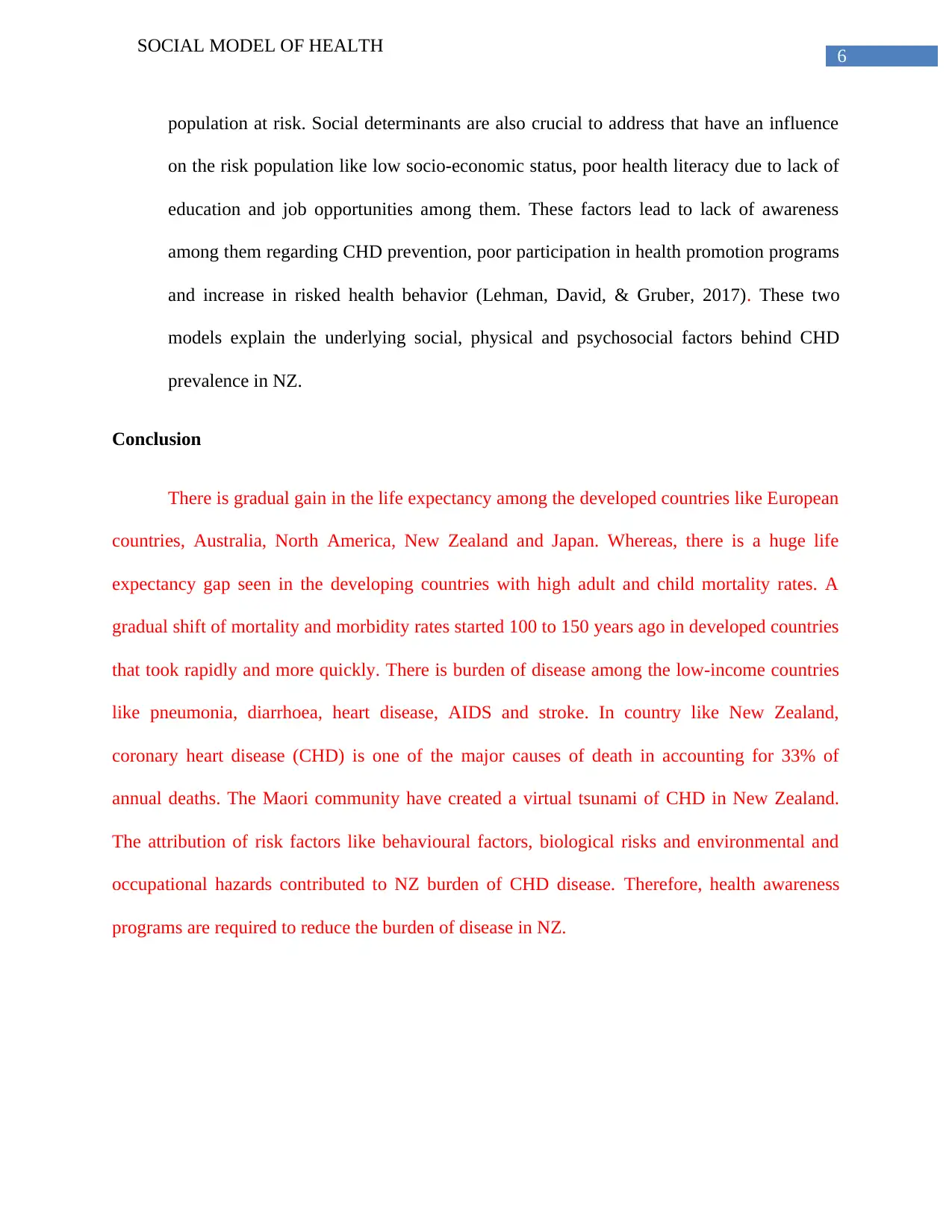
6
SOCIAL MODEL OF HEALTH
population at risk. Social determinants are also crucial to address that have an influence
on the risk population like low socio-economic status, poor health literacy due to lack of
education and job opportunities among them. These factors lead to lack of awareness
among them regarding CHD prevention, poor participation in health promotion programs
and increase in risked health behavior (Lehman, David, & Gruber, 2017). These two
models explain the underlying social, physical and psychosocial factors behind CHD
prevalence in NZ.
Conclusion
There is gradual gain in the life expectancy among the developed countries like European
countries, Australia, North America, New Zealand and Japan. Whereas, there is a huge life
expectancy gap seen in the developing countries with high adult and child mortality rates. A
gradual shift of mortality and morbidity rates started 100 to 150 years ago in developed countries
that took rapidly and more quickly. There is burden of disease among the low-income countries
like pneumonia, diarrhoea, heart disease, AIDS and stroke. In country like New Zealand,
coronary heart disease (CHD) is one of the major causes of death in accounting for 33% of
annual deaths. The Maori community have created a virtual tsunami of CHD in New Zealand.
The attribution of risk factors like behavioural factors, biological risks and environmental and
occupational hazards contributed to NZ burden of CHD disease. Therefore, health awareness
programs are required to reduce the burden of disease in NZ.
SOCIAL MODEL OF HEALTH
population at risk. Social determinants are also crucial to address that have an influence
on the risk population like low socio-economic status, poor health literacy due to lack of
education and job opportunities among them. These factors lead to lack of awareness
among them regarding CHD prevention, poor participation in health promotion programs
and increase in risked health behavior (Lehman, David, & Gruber, 2017). These two
models explain the underlying social, physical and psychosocial factors behind CHD
prevalence in NZ.
Conclusion
There is gradual gain in the life expectancy among the developed countries like European
countries, Australia, North America, New Zealand and Japan. Whereas, there is a huge life
expectancy gap seen in the developing countries with high adult and child mortality rates. A
gradual shift of mortality and morbidity rates started 100 to 150 years ago in developed countries
that took rapidly and more quickly. There is burden of disease among the low-income countries
like pneumonia, diarrhoea, heart disease, AIDS and stroke. In country like New Zealand,
coronary heart disease (CHD) is one of the major causes of death in accounting for 33% of
annual deaths. The Maori community have created a virtual tsunami of CHD in New Zealand.
The attribution of risk factors like behavioural factors, biological risks and environmental and
occupational hazards contributed to NZ burden of CHD disease. Therefore, health awareness
programs are required to reduce the burden of disease in NZ.
Paraphrase This Document
Need a fresh take? Get an instant paraphrase of this document with our AI Paraphraser

7
SOCIAL MODEL OF HEALTH
SOCIAL MODEL OF HEALTH
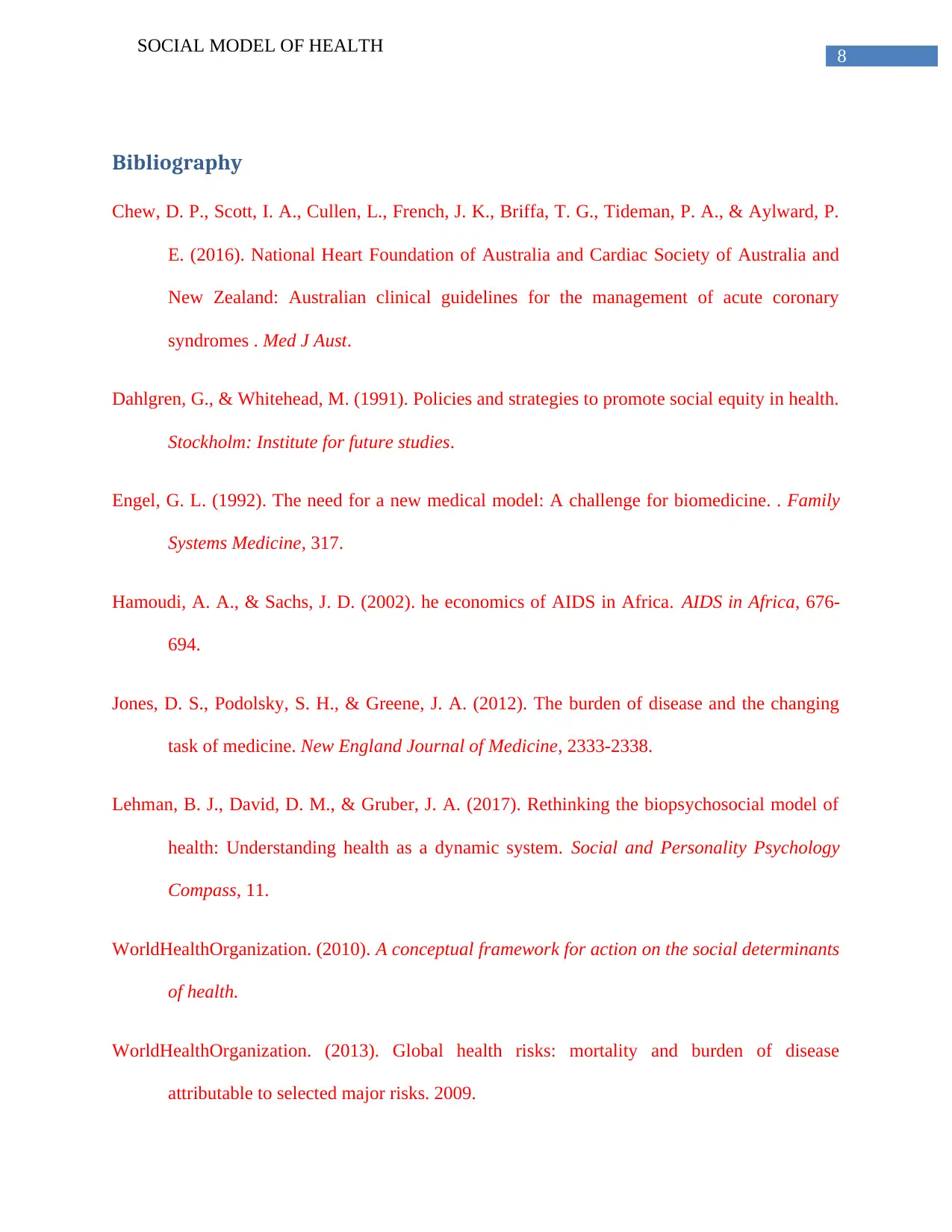
8
SOCIAL MODEL OF HEALTH
Bibliography
Chew, D. P., Scott, I. A., Cullen, L., French, J. K., Briffa, T. G., Tideman, P. A., & Aylward, P.
E. (2016). National Heart Foundation of Australia and Cardiac Society of Australia and
New Zealand: Australian clinical guidelines for the management of acute coronary
syndromes . Med J Aust.
Dahlgren, G., & Whitehead, M. (1991). Policies and strategies to promote social equity in health.
Stockholm: Institute for future studies.
Engel, G. L. (1992). The need for a new medical model: A challenge for biomedicine. . Family
Systems Medicine, 317.
Hamoudi, A. A., & Sachs, J. D. (2002). he economics of AIDS in Africa. AIDS in Africa, 676-
694.
Jones, D. S., Podolsky, S. H., & Greene, J. A. (2012). The burden of disease and the changing
task of medicine. New England Journal of Medicine, 2333-2338.
Lehman, B. J., David, D. M., & Gruber, J. A. (2017). Rethinking the biopsychosocial model of
health: Understanding health as a dynamic system. Social and Personality Psychology
Compass, 11.
WorldHealthOrganization. (2010). A conceptual framework for action on the social determinants
of health.
WorldHealthOrganization. (2013). Global health risks: mortality and burden of disease
attributable to selected major risks. 2009.
SOCIAL MODEL OF HEALTH
Bibliography
Chew, D. P., Scott, I. A., Cullen, L., French, J. K., Briffa, T. G., Tideman, P. A., & Aylward, P.
E. (2016). National Heart Foundation of Australia and Cardiac Society of Australia and
New Zealand: Australian clinical guidelines for the management of acute coronary
syndromes . Med J Aust.
Dahlgren, G., & Whitehead, M. (1991). Policies and strategies to promote social equity in health.
Stockholm: Institute for future studies.
Engel, G. L. (1992). The need for a new medical model: A challenge for biomedicine. . Family
Systems Medicine, 317.
Hamoudi, A. A., & Sachs, J. D. (2002). he economics of AIDS in Africa. AIDS in Africa, 676-
694.
Jones, D. S., Podolsky, S. H., & Greene, J. A. (2012). The burden of disease and the changing
task of medicine. New England Journal of Medicine, 2333-2338.
Lehman, B. J., David, D. M., & Gruber, J. A. (2017). Rethinking the biopsychosocial model of
health: Understanding health as a dynamic system. Social and Personality Psychology
Compass, 11.
WorldHealthOrganization. (2010). A conceptual framework for action on the social determinants
of health.
WorldHealthOrganization. (2013). Global health risks: mortality and burden of disease
attributable to selected major risks. 2009.
⊘ This is a preview!⊘
Do you want full access?
Subscribe today to unlock all pages.

Trusted by 1+ million students worldwide

9
SOCIAL MODEL OF HEALTH
www.health.govt.nz. (2016, August 21). Health Loss in New Zealand 1990–2013. Ministry of
Health NZ. . Retrieved from www.health.govt.nz.:
http://www.health.govt.nz/publication/health-loss-new-zealand-1990-2013
Zealand, S. N. (2012). Demographic trends 2010.
SOCIAL MODEL OF HEALTH
www.health.govt.nz. (2016, August 21). Health Loss in New Zealand 1990–2013. Ministry of
Health NZ. . Retrieved from www.health.govt.nz.:
http://www.health.govt.nz/publication/health-loss-new-zealand-1990-2013
Zealand, S. N. (2012). Demographic trends 2010.
1 out of 10
Related Documents
Your All-in-One AI-Powered Toolkit for Academic Success.
+13062052269
info@desklib.com
Available 24*7 on WhatsApp / Email
![[object Object]](/_next/static/media/star-bottom.7253800d.svg)
Unlock your academic potential
Copyright © 2020–2025 A2Z Services. All Rights Reserved. Developed and managed by ZUCOL.





